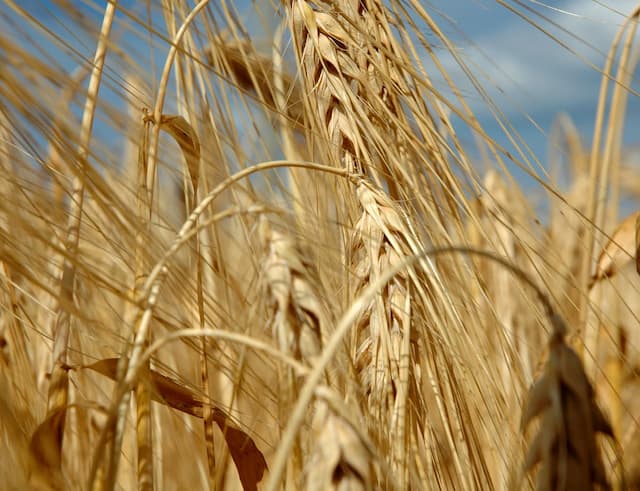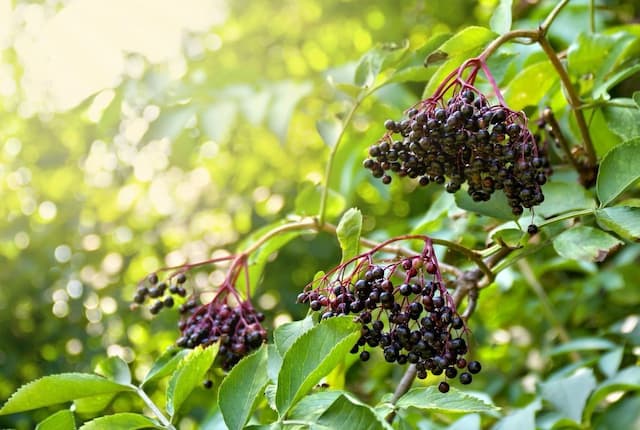Golden Elderberry Sambucus nigra 'Aurea'

ABOUT
The plant known as golden elderberry showcases strikingly vibrant yellow foliage that has a distinct lacy texture. The bright yellow leaves emerge in spring with an almost chartreuse hue and as they mature, they transform into a deeper golden color. The leaves themselves are made up of multiple small leaflets that create a compound, feather-like appearance. In early summer, the golden elderberry produces an abundance of cream-colored flowers, which are arranged in large, flat-topped clusters that stretch across the plant. These flowers are not only attractive but emit a sweet fragrance that can attract pollinators such as bees and butterflies. Following the flowering period, the plant yields small dark purple to black berries. These berry clusters are highly appealing to various species of birds and other wildlife, making it an excellent choice for those looking to enhance biodiversity in their garden. In contrast to its vibrant spring and summer display, during fall, the foliage tends to fade to a softer yellow color before shedding its leaves for the winter season. The overall visual effect of the golden elderberry is one of a lively, textured, and colorful specimen that provides multiple seasons of visual interest in the garden.
About this plant
 Names
NamesFamily
Adoxaceae.
Synonyms
Golden Elderberry, Golden European Elder, Golden Elder.
Common names
Sambucus nigra 'Aurea'.
 Toxicity
ToxicityTo humans
The common name for Sambucus nigra 'Aurea' is elderberry. Most parts of the elderberry plant are poisonous to humans when consumed raw or unprepared. This includes leaves, twigs, seeds, roots, and unripe or raw fruits which contain cyanogenic glycosides. When ingested, these substances can cause symptoms including nausea, vomiting, diarrhea, dizziness, and headaches. Severe poisoning can potentially lead to more serious symptoms like difficulty breathing, weakness, and seizures. Cooking the berries properly destroys the toxic compounds, making ripe berries safe to consume.
To pets
Elderberry, the common name for Sambucus nigra 'Aurea', is also toxic to pets. The plant contains cyanogenic glycosides, primarily in its leaves, twigs, seeds, roots, and unripe or raw fruits. If pets ingest these parts of the elderberry plant, they may exhibit symptoms such as vomiting, diarrhea, abdominal pain, and lethargy. In severe cases, cyanide poisoning can lead to more serious issues like difficulty breathing, seizures, and potentially be fatal. Ripe berries are less toxic, but it's generally recommended to keep pets away from the plant to ensure their safety.
 Characteristics
CharacteristicsLife cycle
Perennials
Foliage type
Deciduous
Color of leaves
Golden
Flower color
White
Height
8-12 feet (2.4-3.7 meters)
Spread
6-10 feet (1.8-3 meters)
Plant type
Shrub
Hardiness zones
4
Native area
Europe
Benefits
 General Benefits
General Benefits- Attractive Foliage – The plant is known for its golden-yellow leaves, adding a splash of color to any landscape.
- Wildlife Habitat – Provides shelter and food for birds, bees, and butterflies, enhancing biodiversity.
- Edible Fruit – Produces black elderberries that can be used in jams, syrups, and wines (though they must be cooked to be safe for consumption).
- Drought Tolerant – Once established, it is fairly drought-resistant, requiring less water compared to other shrubs.
- Fast-Growing – Rapid growth allows for quick establishment and filling in of garden areas.
- Erosion Control – Its root system helps to stabilize soil and prevent erosion on slopes.
- Low Maintenance – Requires minimal pruning and care once established in a suitable location.
- Versatile Landscaping – Can be used in a variety of landscape settings, including hedges, screens, or standalone ornamental elements.
- Seasonal Interest – Offers visual interest throughout multiple seasons with changing foliage colors and berry production.
- Tolerant of Different Soil Types – Adapts to a wide range of soils, although it prefers well-drained, fertile ground.
 Medical Properties
Medical Properties- Immune Support: The elderberry flowers and fruits have been traditionally used to enhance immune function.
- Respiratory Health: Elderberry is commonly used for its potential to alleviate symptoms associated with the common cold and flu, such as coughs and sore throats.
- Antioxidant Effects: Elderberries have high levels of flavonoids, which are compounds that possess antioxidant properties to help protect cells from damage.
- Anti-inflammatory: The berries and flowers may provide anti-inflammatory benefits.
- Diuretic Effect: Elderflower is traditionally used for its diuretic properties, having the potential to aid in fluid reduction.
- Antiviral Activity: Some studies suggest that elderberry extracts have antiviral properties, particularly against certain strains of the influenza virus.
- Skin Health: Topical applications of elderflower-infused products are used to improve skin health, though these are primarily cosmetic rather than strictly medical.
 Air-purifying Qualities
Air-purifying QualitiesThis plant is not specifically known for air purifying qualities.
 Other Uses
Other Uses- Elderflower-infused liquids: The flowers of the elder can be used to infuse water, vinegar, or oils with its flavor, which can then be used in culinary applications or as a natural fragrance in home products.
- Natural dye: The flowers and berries of the elder can be used to create natural dyes for textiles or crafts, yielding shades ranging from deep blue and purple to lighter pastels depending on the mordant used.
- Garden landscaping: With its striking golden foliage, Elder 'Aurea' is often planted as an ornamental feature in gardens to add contrast and visual interest.
- Photography prop: The vibrant and attractive flowers and foliage of elder 'Aurea' are sometimes used as a backdrop or feature in portrait and macro photography.
- Floral arrangements: Fresh or dried elderflowers are used in floral arrangements to add a unique texture and scent, contributing a rustic and natural aesthetic.
- Wildlife habitat: Elders can provide important habitat and food for wildlife, particularly birds who benefit from the berries and insects that are attracted to the flowers.
- Musical instruments: In traditional cultures, the hollow stems of the elder have been used to make simple musical instruments like flutes and whistles.
- Culinary garnish: Elderflowers can be crystallized with sugar and used to decorate desserts, adding both visual appeal and a subtle floral flavor.
- Craft materials: The branches and stems of elder can be used in basket making, providing a natural and sturdy material for weaving.
- Companion planting: Elder 'Aurea' may be used in companion planting schemes intended to attract beneficial insects to the garden or to provide light shade for shade-loving plants.
Interesting Facts
 Feng Shui
Feng ShuiThe Black Elderberry, commonly known as Sambucus nigra 'Aurea', is not used in Feng Shui practice.
 Zodiac Sign Compitability
Zodiac Sign CompitabilityThe Black Elderberry is not used in astrology practice.
 Plant Symbolism
Plant Symbolism- Protection: Sambucus nigra, commonly known as Elderberry, has been associated with protection in folklore. It was believed that planting an elder near your house would protect the inhabitants from evil spirits.
- Healing: Elderberry has a long history of being used in traditional medicine. Its symbolic meaning of healing derives from its use for treating various ailments, from flu and colds to inflammation.
- Rebirth: The plant's ability to regenerate and grow back even after being cut down has led to its symbolic association with rebirth and renewal.
- Transformation: Elderberry's various stages of growth from flowers to dark berries symbolize transformation and the cyclical nature of life.
- Prosperity: In some traditions, the elder tree was thought to bring good luck and prosperity to the household it was grown near.
 Water
WaterThe Golden Elderberry should be watered deeply but infrequently to encourage a strong root system. Typically, this means giving the plant about 1-2 gallons of water per week, depending on weather conditions. During hot or dry periods, increase the frequency of watering to ensure the soil remains consistently moist but not waterlogged. In cooler months, reduce the frequency as the plant requires less water. Always check the top 2-3 inches of soil for dryness before watering.
 Light
LightGolden Elderberry thrives in full sunlight to partial shade. The ideal location is one where it can receive at least six hours of direct sunlight daily, which promotes the best foliage color and flower production. If the location is too shaded, the plant's growth may be less robust, and it may produce fewer flowers.
 Temperature
TemperatureThe Golden Elderberry prefers temperate climates and can tolerate temperatures ranging from about -10°F to 95°F. However, the ideal temperature range for optimal growth is between 60°F and 75°F. It's hardy to USDA zones 4 through 7, so it can withstand some freezing conditions but should be protected from extreme cold.
 Pruning
PruningThe Golden Elderberry benefits from annual pruning to maintain its shape and promote vigorous growth. The best time to prune is late winter or early spring before new growth begins. Remove any dead or damaged wood, and thin out crowded areas to allow for better air circulation. Pruning can also stimulate flower production, so cutting back old stems can result in a more bountiful bloom the following season.
 Cleaning
CleaningAs needed
 Soil
SoilGolden Elderberry requires well-drained, fertile soil with high organic matter. The best soil mix is a blend of loam, peat, and sand to ensure good drainage and aeration. A slightly acidic to neutral pH of 5.5 to 7.5 is ideal for this plant.
 Repotting
RepottingGolden Elderberry is typically not repotted as it is a large shrub; instead, it is planted outdoors. However, if grown in a container, repotting every 2-3 years may be necessary to provide fresh soil and additional growing space.
 Humidity & Misting
Humidity & MistingGolden Elderberry prefers average ambient humidity but is adaptable to a range of conditions. It does not require any special humidity adjustments when grown outdoors in its natural environment.
 Suitable locations
Suitable locationsIndoor
Ensure bright light and room to grow.
Outdoor
Place in full sun; well-draining fertile soil.
Hardiness zone
4-7 USDA
 Life cycle
Life cycleThe life of the European Elderberry 'Aurea' (Sambucus nigra 'Aurea') begins with seed germination after a period of cold stratification, which breaks the seed's dormancy. Following germination, the seedling stage involves growth of the primary root, stem, and embryonic leaves. As the plant enters the vegetative stage, it develops a woody stem, compound leaves with a distinctive golden-yellow color, and increases in height and girth. The European Elderberry 'Aurea' reaches maturity within a few years, whereupon it flowers annually, producing large clusters of fragrant, cream-colored flowers that are attractive to pollinators. After pollination, the flowers develop into dark purple berries that are a food source for wildlife and can be used by humans in jams, syrups, and wines. The plant can live for many years, continuing to grow and produce flowers and fruit, with some plants reaching up to 30 years of age under ideal conditions.
 Propogation
PropogationPropogation time
Early Spring
The European elderberry, Sambucus nigra 'Aurea', can be propagated by taking softwood cuttings during late spring to early summer when the plant's growth is most vigorous. The most popular method of propagation is via these softwood cuttings. To do this, select healthy, non-flowering shoots and cut a segment 6 to 8 inches (15 to 20 centimeters) long. The leaves on the lower half of the cutting should be removed and the cut end dipped into a rooting hormone to encourage root development. The prepared cutting should then be planted in a mixture of half peat and half perlite or sand, ensuring good contact between the cutting and the growing medium. The environment should maintain high humidity, which can be achieved by covering the cuttings with a plastic bag or placing them in a propagator. The cuttings typically take several weeks to root, after which they can gradually be acclimatized to outdoor conditions before planting out.


![Elder [Black Tower]](/_next/image?url=https%3A%2F%2Fplants-admin.emdemapps.com%2Fimages%2Fplants%2F%2Fimages%2F604b5cad99578.png&w=640&q=75)






